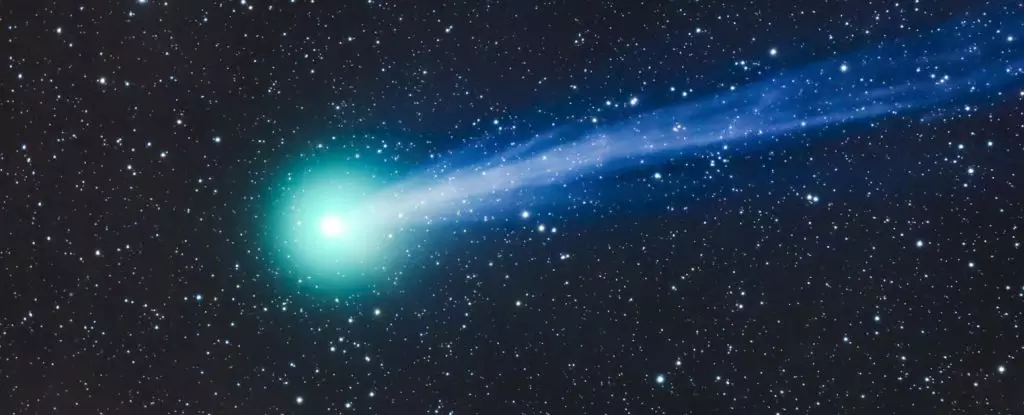The recent imagery captured during the September 7 lunar eclipse has ignited a wave of curiosity among astronomers and space enthusiasts alike. Interstellar comet 3I/ATLAS has displayed a mesmerizing greenish hue—a phenomenon commonly associated with comets heating up as they approach the Sun. Yet, beneath this familiar glow lies a perplexing chemical anomaly that challenges our understanding of cometary composition. Unlike typical comets which fluoresce green due to the presence of the diatomic carbon molecule (C2), 3I/ATLAS’s spectral signature hints at a fundamentally different chemistry. This comet’s color could be a window into rare or yet undetected molecules, suggesting that it might harbor secrets that could redefine our knowledge of interstellar objects.
The green glow on comets generally results from the fluorescence of C2 molecules. When sunlight ignites the sublimating ices from a comet’s nucleus, specific molecules absorb energy and emit characteristic colors. The prominence of green fluorescence has become almost emblematic of many solar system comets, making 3I/ATLAS’s deviation all the more intriguing. Its unusual spectral signature signals an atypical chemical makeup, reflecting that interstellar comets may not conform to traditional models. This deviation sparks questions about the formation environments of such objects—do they originate from significantly different stellar systems that craft them with unique chemical inventories?
Decoding the Chemical Anomaly
What truly elevates the mystery surrounding 3I/ATLAS is the absence, or at least the faintness, of molecules typically responsible for green fluorescence. Observations, notably from the James Webb Space Telescope, show that 3I/ATLAS contains an excess of carbon dioxide and possibly other complex molecules like nickel and cyanogen. Yet, despite these findings, the expected abundance of C2 molecules remains elusive. A recent study from the University of Michigan highlights a startling depletion of carbon-chain molecules, including C2 and C3, which are usually abundant in comets. The ratio of C2 to cyanogen (CN), a key marker of comet chemistry, is extraordinarily low—placing this interstellar visitor among the most carbon-depleted comets documented.
This chemical anomaly suggests several possibilities. Could it mean that 3I/ATLAS’s molecules are out of phase with what we typically observe? Or perhaps its molecules are so different that they fluoresce in a way we haven’t yet identified. It also raises the question whether our current detection methods are capable of capturing the full scope of its chemistry, or if some molecules remain hidden, cloaked in spectral regions beyond our observational reach. Either way, the findings disrupt conventional wisdom and signal that interstellar comets like 3I/ATLAS might be fundamentally different from their solar system counterparts.
Implications for Interstellar Origins and Future Research
This chemical enigma does more than just challenge existing comet models; it offers a tantalizing glimpse into the diverse cosmic environments from which these objects originate. Interstellar comets traverse the galaxy, possibly sampling a variety of planetary systems with distinct chemical footprints. The case of 3I/ATLAS could indicate it formed around a star with a markedly different chemical composition than our Sun, or it may have undergone unique evolutionary processes that altered its makeup.
As the comet approaches Earth again in December, there’s an eager call for detailed observations. Future studies will aim to decipher whether the apparent absence of C2 is an observational artifact or a genuine characteristic. The potential discovery of an alternative molecule responsible for its green glow could revolutionize our understanding of cometary chemistry across the galaxy. It also emphasizes the importance of developing more sophisticated detection techniques, capable of probing molecules that elude existing spectra.
In the grander scheme, 3I/ATLAS serves as a cosmic ambassador—an interstellar traveler bringing us clues about worlds beyond our solar neighborhood. Its peculiar chemistry is a stark reminder that the universe still holds countless surprises, beckoning us to refine our theories and extend our grasp of cosmic diversity. Whether it turns out to be a once-in-a-lifetime anomaly or the tip of an interstellar iceberg, one thing is certain: the universe is far more complex—and fascinating—than many of us have yet imagined.


Leave a Reply